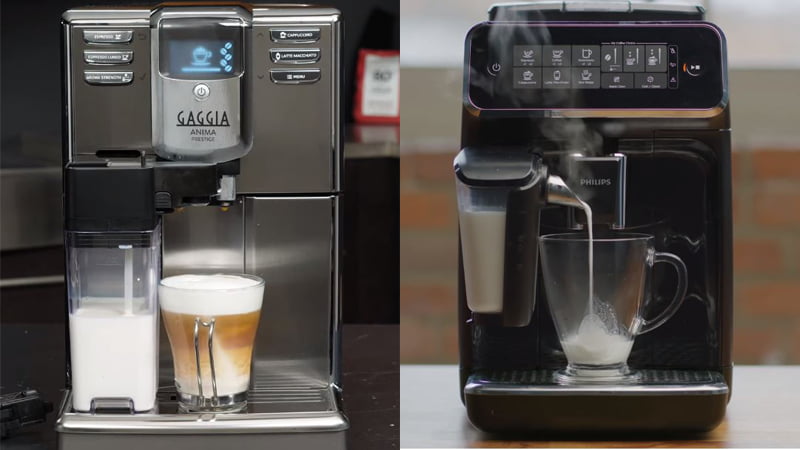For those with a budget under $1000 eyeing a one-touch espresso machine, I present two contenders: the Gaggia Anima Prestige vs Philips 3200 LatteGo. After careful comparison, I noticed that the latter was a little better.
Both let you make espresso or cappuccino yourself with some commendable features such as a ceramic grinder, a Thermoblock fast-heating system, an automatic milk system, etc. The Philips 3200 offers more grinding settings, has a cup warmer, sports a larger water tank and bean hopper, and is lighter. Meanwhile, the Gaggia Anima Prestige stands out with its superior espresso quality and a better milk system.
Gaggia Anima Prestige Vs Philips 3200 LatteGo: Comparison Chart


Last update on 2025-03-23 / Affiliate links / Images from Amazon Product Advertising API
Gaggia Anima Prestige Vs Philips 3200 LatteGo: Differences
The Philips 3200 LatteGo is better than the Gaggia Anima Prestige with a score of 4-3. That is just the tip of the iceberg, so keep reading to see more!
Coffee Flavour
Winner: Tie
Built-in Grinder
Both have a robust built-in ceramic burr grinder. That means you don’t need to invest in a separate grinder, saving you time and money and streamlining the coffee-making process. The burr grinder grinds the beans instead of “chopping” them as its blade counterpart – it results in a consistent and uniform grind size, which is essential for optimal flavor extraction.
The ceramic grinder is known to last longer and be more resistant to wear and tear than the stainless steel one. Ceramic is a material that can minimize heat during grinding, preserving the integrity of the coffee beans’ natural flavors and aromas. Also, it works pretty quietly, ensuring a quiet coffee-making experience.
In terms of the ability to control the grind of coffee grounds, the Gaggia Anima Prestige has only 5 different grinding settings, whereas the Philips 3200 is ahead of the game with up to 12 settings. You can change the grind size on the Philips 3200 by just turning the knob (counterclockwise = finer and clockwise = coarser). As for the Anima Prestige, you will need to use the special tool attached to the end of the dosing spoon.
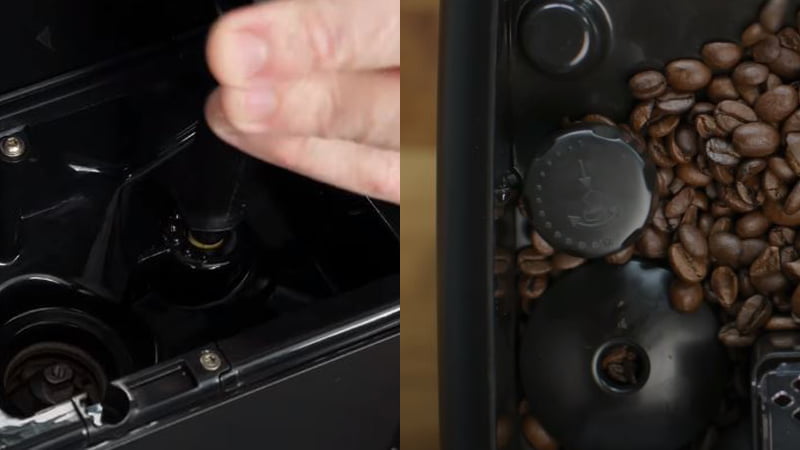
It is worth noting that you should only change the grind size when the grinder is running to avoid jamming it. Also, it’s best to avoid oil beans because they can lead to clogging and blockages in the grinder’s burrs.
Heating System
These machines have a single Thermoblock fast-heating system. Right off the bat, they can’t brew coffee and prepare milk froth at once, a boon for large settings like coffee shops or offices where there is a demand for quickly preparing multiple milk-based beverages at once. But for home use, this limitation is generally not a significant concern as the Thermoblock system heats up very quickly.
Thermoblock only heats the amount of water required for each process, so the delay time is just a matter of seconds (about 20 seconds). This is a huge step up from a traditional boiler, which heats a larger quantity of water and can take tens of minutes to reach the optimum temperature. As a bonus, it is a more eco-friendly approach to coffee preparation and ensures your espresso is always made with freshly heated water.
The Philips 3200 has a passive cup warming plate. This is a welcome add-on since you can use it to pre-heat your cup to minimize heat loss from your espresso when frothing milk.
Brewing System
Both of these machines have a pre-infusion function. If there is one thing that always rings true in the realm of the espresso machine, it is that this pre-brew process always leads to a delicious and full-bodied espresso.
But what is pre-infusion? Well, it basically saturates the coffee grounds with hot water before extraction begins. This process leads to a rich and full-bodied espresso with a more balanced and nuanced flavor profile. Moreover, it minimizes channeling, which leads to uneven extraction (over- or under-extraction).
Then, once the grounds “bloom” thanks to the pre-infusion stage, these bean-to-cup machines will brew espresso at a pressure of 15 bars. The minimum pressure required to pull a high-quality espresso shot is 9 bars, so you can rest assured that they are more than enough to extract coffee properly.
I found the Gaggia Anima Prestige to produce a rich, full-bodied espresso topped with a fairly thick layer of crema. It’s far from the best one, but it is probably above average compared to other models in the same price bracket.
The espresso that came out of the Philips 3200, on the other hand, was somewhat thin and a wee bit watery, while the crema layer was not as thick as I expected. That seems to be the consequence of the fact that this one extracts espresso too quickly (because the filter basket features large holes, letting the water pass too quickly).
Milk Frothing System
They have automatic milk frothing systems, allowing you to create home versions of milk-based drinks at coffee shops. So you can have your go-to cappuccino or latte from the comfort of your own kitchen instead of visiting your familiar barista. The automatic milk system means you don’t need to spend time and effort practicing frothing milk – just press a button, hold your horses for a moment, and then relish your drink.
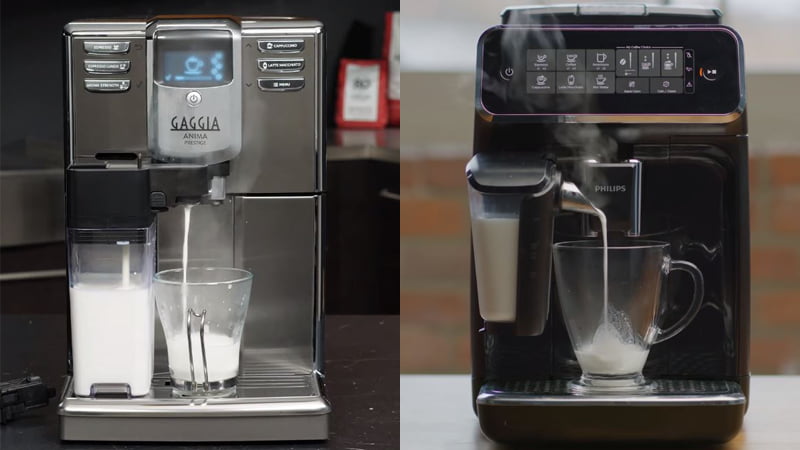
The Anima Prestige boasts an integrated milk carafe that is neatly attached to the front of the machine without any tubes or other parts to prepare a milky drink. With the push of a button, it will steam the milk properly and pour a stream of velvety milk foam straight into a waiting cup. Afterward, with a quick touch of the button, the machine will flush a stream of hot water through the circuit to purge any residual milk within moments. The milk pitcher is detachable, and you can put it in your fridge after each use to keep the milk cold and ready for subsequent use.
On the flip side, the Philips 3200 also has a removable milk pitcher called “LatteGo,” as its name suggests. I like that its holder has some notches to indicate how much milk you should pour for each purpose (x1 cappuccino, x1 latte macchiato, and x2 cappuccino). You’ll have to ensure it’s firmly clamped on a holder, or it will spill over, and you’ll have to spend extra time cleaning up a sweet white mess. Also, the lid feels a bit flimsy.
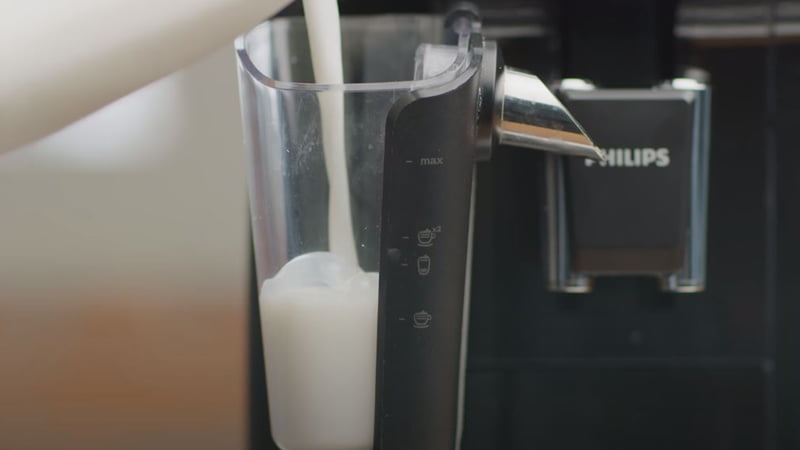
Regarding froth quality, the Philips 3200 produces consistent, thick foam, which is better suited for a cappuccino than a latte. The Anima Prestige was able to bring a great cappuccino to the table as well. Its latte was acceptable but still fell short when pitted against one made by a skilled barista using a wand-fitted machine.
Design & Usability
Winner: Philips 3200 LatteGo
Dimensions, Footprint, & Weight
| Gaggia Anima Prestige | Philips 3200 LatteGo | |
|---|---|---|
| Dimensions | 8.7 x 13.4 x 17.0 inches | 9.7 x 14.6 x 17 inches |
| Weight | 19.1 lbs | 17.7 lbs |
I know that the aesthetics of an espresso machine might not be the primary consideration for everyone, as beauty is only skin deep. But wouldn’t it be quite fantastic to have something that satisfies both your craving for coffee and your sight?
These machines aren’t as flashy as a sci-fi spaceship, but they’re still classy and won’t detract from your kitchen’s aesthetics. Although their cases are mostly plastic, they still feel solid, and there’s no hint that they might break under normal use conditions. To give a sense of luxury without inflating costs, the Anima Prestige has a stainless steel front, while the Philips 3200 is adorned with chrome accents.
When it comes to the control panel, the Gaggia Anima Prestige gave me a ticket to my childhood with its pixelated screens surrounded by classic buttons, evoking the feel of a 90s gaming console. Meanwhile, the Philips 3200 features an intuitive, mammoth-sized screen.
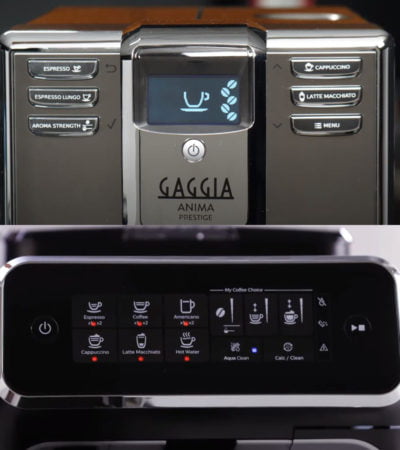
They have a compact design and minimal footprint, so they don’t take up as much counter space and can easily fit under upper cupboards. They’re not particularly heavy, but moving them can be a sweaty endeavor for physically weak guys.
Pre-programmed Coffee Options
| Gaggia Anima Prestige | Philips 3200 LatteGo |
|---|---|
| Espresso Espresso Lungo Cappuccino Latte Macchiato Milk Froth Hot Water | Espresso Black Coffee Americano Cappuccino Latte Macchiato Hot Water |
As you can see, neither offers a diverse collection of one-touch drinks. So if you’re going to turn your kitchen into a miniature coffee shop with all the drinks under the sun, these might not be the machines for you. But if your coffee preferences gravitate primarily towards espresso and cappuccino, just like mine, these machines will serve you well. They also give you the option of using ground coffee if your bean stock runs out or your guests request a swift decaf.
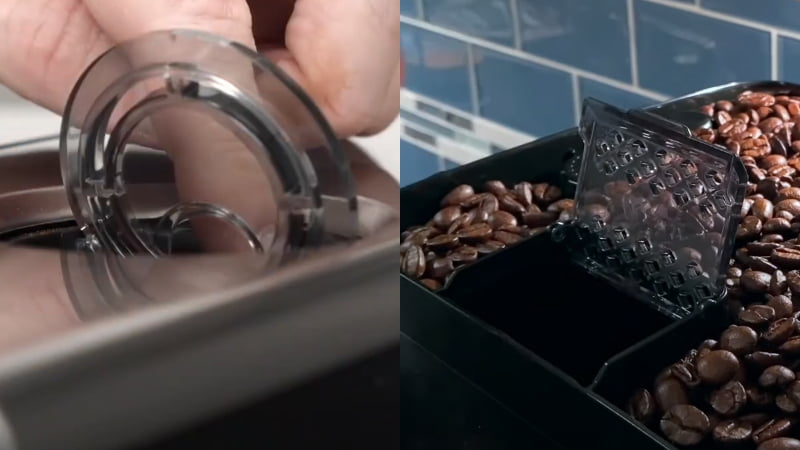
As with other automatic espresso machines, they enable you to play with some settings if the factory one doesn’t satisfy you. The Anima Prestige offers a choice of 5 aroma strength levels and 3 brewing temperatures. Additionally, they allow you to adjust the dosage of espresso and milk froth to your liking and remember these personalized settings for future use, courtesy of the “Memo” function. On the other hand, Philips 3200 LatteGo has 3 levels of strength coffee, water dosage, and quantity of milk froth.
Spout & Cup Clearance
| Gaggia Anima Prestige | Philips 3200 LatteGo | |
|---|---|---|
| Spout Type | Dual | Dual |
| Cup Clearance | 4.3–6.5 inches | 3.3–6.9 inches |
Their butterfly-shaped espresso spouts provide flexible vertical movement to fit a wider range of cups, including large travel mugs, and preserve the delightful crema layer atop your espresso. I loved their double-shot function. They actually brew two separate espressos instead of just doubling the water volume and maintaining the same quantity of coffee.
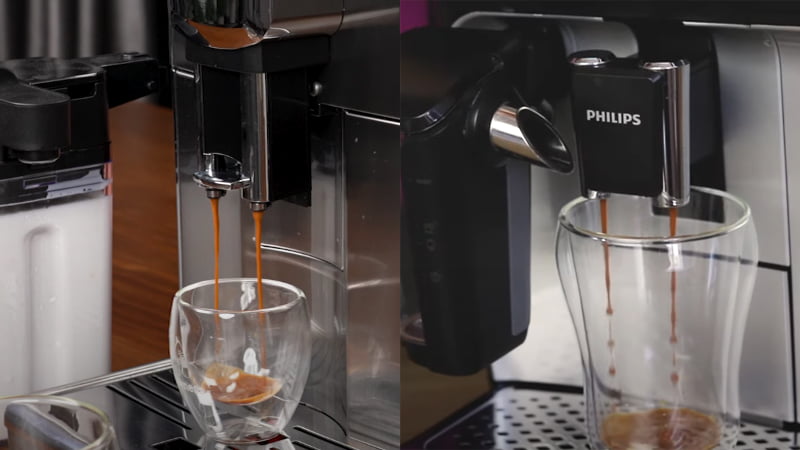
The milk spigot of the Philips 3200’s carafe can be quite high relative to your cup, especially if you want to brew a smaller drink like a cappuccino. Given the length of the journey the milk has to make before it reaches your cup, incorrect placement of the cup could lead to an unfortunate spill on your counter.
Water Reservoir & Bean Hopper
| Gaggia Anima Prestige | Philips 3200 LatteGo | |
|---|---|---|
| Water Reservoir | 1.77 liter | 1.8 liter |
| Bean Hopper | 0.26 liter | 0.28 liter |
Their water tanks are easy to refill and clean. You have the option of using the included water filter (Intenza+ and AquaClean water filters) and replacing it after one or a few months, depending on how often you use the machine. Unless you’re using bottled water (I know, it sounds a bit impractical) or your kitchen faucet comes with a built-in filter, I highly recommend it to reduce the frequency of descaling the machine and ensure your espresso always tastes good.
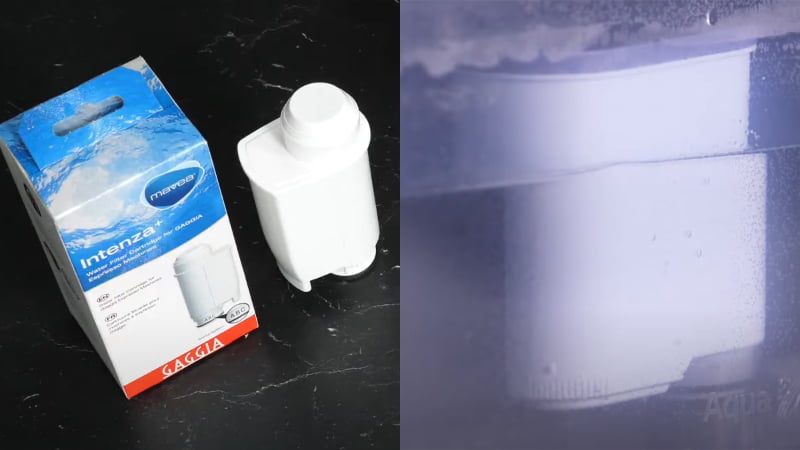
Their bean feeders can hold up to 300 grams of coffee beans. The 3200 LatteGo has an airtight lid, while the Anima Prestige doesn’t. This is a big concern since preventing beans from being exposed to the elements is the key to keeping them fresh with a full aroma for a long time.
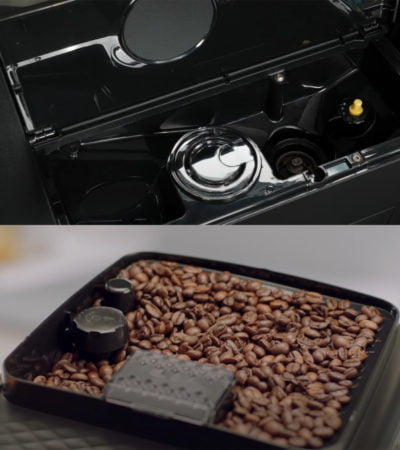
Cleaning & Maintenance
Winner: Tie
Both have some removable parts that need to be cleaned manually under the tap, such as the drip tray, the dregs basket, the dual spout, the water tank, the brew group, the milk pitcher, etc. You should also give the machine’s housing and external surfaces a wipe using a damp cloth regularly to remove any dust or stains, keeping the machine looking clean and maintaining its shine.
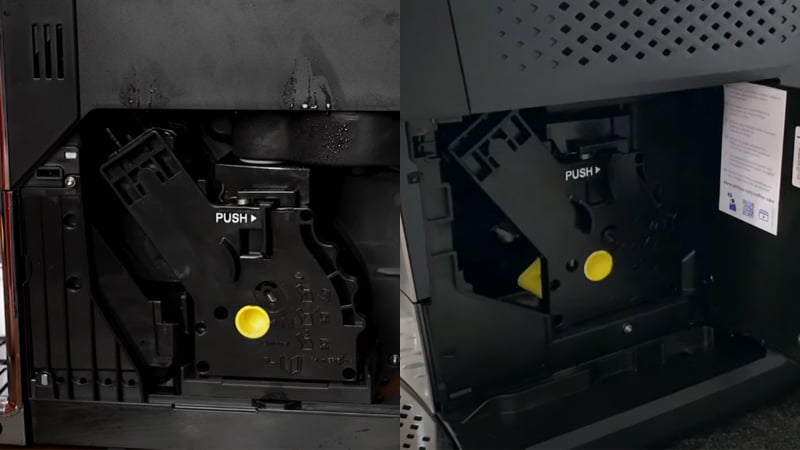
Even if you use the filter, these kitchen appliances still need to be descaled after a certain period of time. You don’t need to set your own reminder because they will prompt you when they detect a need for descaling (based on usage and water hardness). Just use the recommended descaling solution and refer to the user manual to activate the automatic descaling cycle, and let the machine do the rest.
Utilities & Other Features
Winner: Tie
Auto Off
If these machines remain inactive for the set interval (ranging from 15 minutes to 3 hours), they will power down to conserve energy.
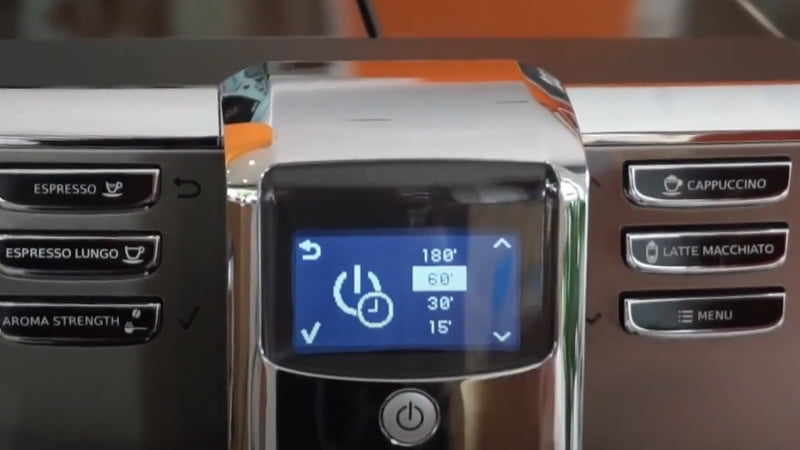
By having the machine go into standby mode when not in use, you can significantly reduce its energy consumption. This not only helps you lower your electricity bills but also contributes to a more eco-friendly approach to coffee preparation.
Quick Rundown Of Philips 3200 LatteGo
- 5 AROMATIC COFFEES: Enjoy your favorite coffees for special moments. Whether you crave an espresso, coffee, americano, cappuccino or a latte macchiato, your fully automatic espresso machine delivers a perfect in-cup result with no hassle and in no time.
- INTUITIVE TOUCH DISPLAY: The irresistible taste and aroma of coffee from fresh beans is just one touch away. Our intuitive touch display allows you to easily select your favorite coffee.
- PERFECT TEMPERATURE AND AROMA: The Aroma Extract system intelligently strikes the optimum balance between brewing temperature and aroma extraction.
- 2 PARTS, NO TUBES MILK SYSTEM: Our 2 parts milk system has no tubes or hidden parts and can be cleaned in as little as 15 seconds under tap or in the dishwasher.
- AQUACLEAN FILTER: By changing the filter after being prompted by the machine, you will not need to descale your machine for up to 5,000 cups, while enjoying clear and purified water.
Last update on 2025-03-23 / Affiliate links / Images from Amazon Product Advertising API
Quick Rundown Of Gaggia Anima Prestige
No products found.
Product Video
Related Articles to Philips 3200
- Saeco Picobaristo Vs Philips 3200: A Detailed Face-Off Comparison
- Philips 3200 Vs Breville Barista Pro: An Honest Comparison
- Saeco Xelsis Vs Philips 3200: Choosing the Better One!
- Jura D6 vs Philips 3200: Can The Affordable Philips 3200 Beat The Mid-Range Jura D6?
- Jura E8 Vs Philips 3200: A Head-To-Head Comparison
- Jura E6 vs Philips 3200: Can Philips 3200 Surpass A Mid-range Machine Like E6?
- Jura A1 vs Philips 3200: Check Out My Honest Comparison For These Potent Espresso Machines
- Philips 3200 vs 3100: Reviewing 2 Cut-Price Espresso Machines
- Philips 3200 vs Terra Kaffe: Classic vs Contemporary – Which One Will Win?
- Philips 3200 Vs Saeco Incanto: A Honest Review & Detailed Comparison
- Philips 3200 vs 5000: Which Is The Best Espresso Machine For Your Budget?
- Philips 3200 vs Delonghi Magnifica XS: 4 Major Differences In Flavor, Milk Frothing, And More
- Philips 3200 Vs 5400: An Honest Comparison Between Two Machines With Various One-touch Beverages
- Philips 3200 LatteGo vs 4300: Which One Is Your Best Bet?
- Philips 3200 Vs 1200: Are They Value For Money?
- Breville Barista Touch Vs Philips 3200: Which One Is Your Best Choice?
- Breville Barista Express Vs Philips 3200: A Hands-On Comparison
- DeLonghi Dinamica Plus Vs Philips 3200 LatteGo: Honest Review & Detailed Comparison
Related Articles to Gaggia Anima Prestige
- Jura D6 vs Gaggia Anima Prestige: The Way Of Espresso – Which One Should You Choose?
- Gaggia Anima Prestige Vs Saeco Picobaristo: Real Tests & Detailed Comparison!
- Gaggia Anima Prestige vs Saeco Incanto: 2 Akin Models – Which Performs More Smoothly?
- Gaggia Anima Prestige vs Accademia: Which Espresso Machine Is Worth The Investment?
- Gaggia Anima Prestige Vs Babila: Which One Is Your Best Bet?
- Gaggia Anima vs Anima Prestige: Is Anima Prestige More Innovative Than The Standard Anima?
- Gaggia Anima Prestige Vs Velasca Prestige: A Head-To-Head Comparison
- Gaggia Cadorna Prestige vs Anima Prestige: Which Of These Gaggia’s Espresso Makers Brews Better?
- Gaggia Anima Prestige Vs Breville Barista Touch: In-Depth Review and Detailed Comparison
References:
- Gaggia Anima Prestige: https://www.gaggia-na.com/products/gaggia-anima-prestige
- Philips 3200 LatteGo: https://www.usa.philips.com/c-e/ho/coffee/espresso/philips-automatic-espresso-machine.html

I’m Floyd J. Alcock, an experienced barista with a deep love for coffee. I curate personalized coffee experiences, guiding customers through diverse flavor profiles and suggesting ideal brewing methods. My extensive knowledge of espresso machines enables me to recommend the best equipment to match specific needs and budgets. Sharing my expertise and passion with coffee enthusiasts brings immense satisfaction. I look forward to continuing my journey of coffee discovery with every customer I serve, fostering connections over a shared love for this magical beverage.
